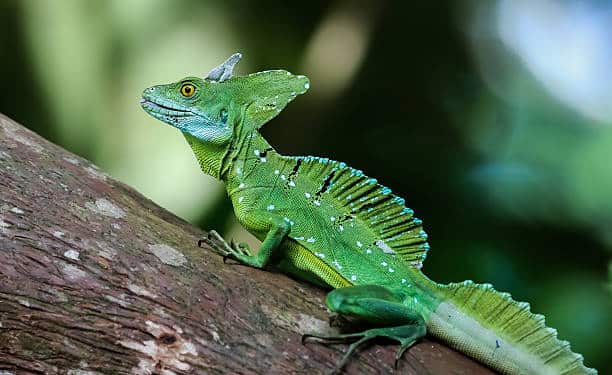There are many animal species that live in various regions of the world. Depending on the geography of the surrounding area, animals can have incredibly distinct lifestyles. Some live in water, some live in dense forests, others live in snow areas and others like the indoors. The best part is that nature is full of all these amazing species to discover right outside your back door!
Table of Contents
#1 King Vulture
This is one of the bigger types of vulture, which can grow up to be 32 inches long. These birds are typically a pure white that often has duller or faded secondary colors around their tail. Their plumes around their heads and necks are bright colors like blue, red, orange, and yellow. The dangling skin called a wattle, is a brilliant shade of red.
Their noses are thick and solid for tearing flesh, and they have long thick hooks that help keep them firmly in place while they’re eating. They’re number 10 on the list of animals found in the rainforest, making them quite tough.
Vultures like these live high up in trees by resting in their branches so they have an unobstructed view over what’s below them. They rely on their incredible vision for spotting other vultures that have found something good to grab onto when it lands nearby.
#2 Electric Eel
Electric eels are ruthlessly merciless, and can deliver a monstrous electric assault of upwards of 600 volts. The absolute most shocking assault is 6000 electrolytes cells in body, which give out one blast with a modest voltage of 600 volt. This relative up to 6 shocks is enough to cause cardiovascular breakdown for any person. The eating routine of an electric eel is savage, utilizing their shock to pursue any prey. Their total length can be more than 8 feet long.
They slant toward water compasses which show new or little water but rising water levels in streams in South America will truly peril them for attack by means of land mass all around developed animals.
Anyway most “fun real facts” articles arrange the electric eel with various other types, they are closer in their innate characteristics to carp and trick. This species is even evening with appalling visual discernment.
#3 Poison Dart Frog
Different types of poison dart frogs show up with different levels of color and brilliance. Those beautiful patterns show potential predators that they’re poisonous. For example, the brilliant spade frog has toxic enough to kill 20,000 mice. Researchers think it’s because frogs eat bugs that give them their poisonousness.
How really do these really weigh in on their prey? With a long sticky tongue they dart out and destroy the clueless bug! The frogs eat numerous natural products such as flies and subterranean insects, youthful crickets, and little scarabs which are the ones researchers think might be responsible for the frogs’ poisonousness. Poison dart frogs live in tropical jungles of central and South America and most types grow up to 3 cm long. There’s no wonder why they’re considered one of the 10 animals in the rainforest list!
#4 Jesus Lizard
The basilisk lizard is so called because it has the eyes of a person and the body of a snake. This species is endemic to the Americas, and can be found near water on the outskirts of rainforest areas in trees.
The normal basilisk is identified by its huge size and high balance like crest along its back. A normal basilisk would have crowns on the head and tail. The two sexes are brown to olive-colored with a white, cream, or yellow stripe on their upper lip connected at one side of their body; these stripes will get higher distinction as they age. Its diet might incorporate bugs, for example scarabs or mythical serpent fly; blossoms and little vertebrates like snakes, birds, eggs, and fish.
#5 Leopard
The leopard is a carnivore that lives in three main venues: females and their bitches, mated males, and people. It’s the female leopards that wander the city searching for prey; it’s the males who stay at home but may just move from location to location. The male leopards always hunt during the day but smaller animals such as impala, springbok and Thomson’s gazelles are what they tend to devour. The female leopards hunt day or night as well but follow their prey to a distance of approximately 60-70 metres.
They charge towards them, trip it during the pursuit, and snack its throat before they bite down on it – too hard actually. Leopard pups typically hatch around 90 days old and typically have 4-6 offspring in each litter with a life span of up to 23 years old.
#6 Howler Monkey
These are two of the best-known Neotropical primates. They are famous for their wails, which can travel more than one mile through thick tropical jungle. These monkeys survive in South and Central America.
Dangers include human predation, living space destruction, and pet trade. Fifteen different species are known to exist. Recently, they were elected into the family Cebidae in a division with pygmy marmosets, now positioned in the family Atelidae.
Most howler monkey species live in groups of six to fifteen individuals; females usually wait until they’re older before they find a mate and start their own group. Mantled howlers are an exception – groups usually consist of 20 or more people with multiple adult males.
The number of male members is correlated with hyoid size and testicle size and is distinct with infant population size; this leads to two specific gatherings consisting of only one male with a larger hyoid and smaller testicles having sex exclusively with females in his respective group while maintaining nonsexual relationships with other males in his group’s gathering.
#7 Jaguar
The jaguar is the only true feline in South America. If left unprotected, it could become one of the Amazon Rainforest’s endangered species. It can weigh up to 120 kilos and has a body length of up to 2.5 meters, making it one of the greatest cats on Earth.
Its unmistakable coat features light yellow-tan fur covered by rosettes on the sides but sometimes can produce an unusual melanistic pattern. The jaguar’s hearty appetite allows it to snack on invertebrates such as turtles without fail, and its killing method is particularly lethal: it bites directly through the skull of mammals to cause a fatal accident in the frontal cortex.
#8 Hoatzin
The hoatzin, a bizarre bird found in the Amazon, may be one of the world’s strangest animals, with its chicken-like appearance and three stomachs. This ancient bird radiates a reptilian-like scent and settles on a noisy decision.
It is clumsy when it flies with its massive wings and little head. Opisthocomus, the Latin name it shares with its plumes, comes from an old name for a pouch on their back with raised feathers that once overprotected the head; they have one extra large claw to defend themselves. Hoatzin chicks can often hide underwater to escape from hunters; adults can lay 4-5 blue spotted eggs at once.
#9 Morpho Butterfly
These butterflies contain numerous types of Neotropical species under the variety Morpho. There’s over 29 recognized species and 147 recognized subspecies, most commonly found in South America, Mexico, and Focal America.
Not only are their distinctive radiant blue coloring caused by the scalloped-back wings that reflect light, but also the underside of the wings is a dull earthy color with numerous eyespots to ward off predators like other bugs when it flies. Whenever these butterflies fly, their brilliant lively blue and earthy colors streak together, making it look like the morpho is appearing and disappearing.
#10 Capybara
They look like a rat found in the area of South America and they’re known as one of the biggest rats on earth. They’re similar to guinea pigs and pixies and are related to other animals breeds like nutria, chinchilla and agouti.
They live in savannahs and thick backwoods and close to water. Capybara is a profound animal variety, but it’s not viewed as being compromised to humans. The capybara has a barrel-shaped body with rosy earthy colored fur on its upper torso, becoming yellowish-brown when it passes down its underbelly. Its perspiration organs can be seen at the base of its bushy densities all around its furry skin – an uncommon aesthetic within rodents.
Summary top 10 animals in the rainforest
Nowadays, the world is littered with beauty. But unfortunately, humans continue to negatively impact nature. As a result, many of the animals mentioned in this list are endangered and near threatened.
Now we hope to continue conversations and sustainable tourism to make sure these animals can be seen by generations that follow.

